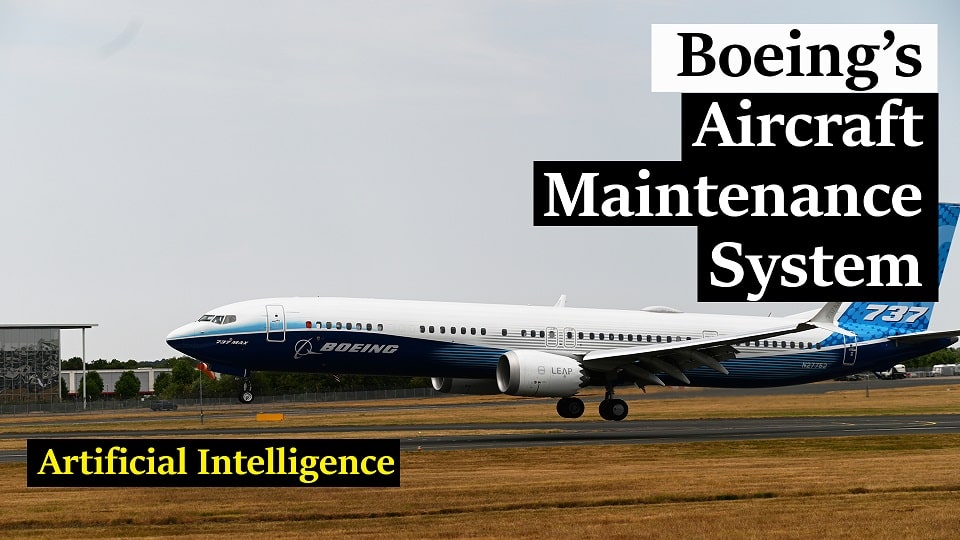Aerospace
Boeing found a new solution for Aircraft Maintenance. How does it work?
This is a brand-new cloud-based digital solution that uses artificial intelligence to run efficiently and prevent very disruptive service outages. #Boeing #Cloud

An insight accelerator powered by AI is being introduced by Boeing for its B737 and B787 airplanes. This is a brand-new cloud-based digital solution that uses artificial intelligence to run efficiently and prevent very disruptive service outages.
Airlines regularly update the logs for aircraft maintenance and the technical data they rely on to sustain the aircraft, which is a labor-intensive process. In order to maintain an aircraft, there are two different forms of maintenance: predictive and unpredictable. In actuality, predictive maintenance helps airlines avoid downtime and service interruption. Any unanticipated issue disrupts the contract and harms the airline’s reputation.
Since technology is constantly evolving, most things are gradually adopting machine learning technology, which essentially addresses the major operational difficulties.
All Nippon Airways Launches Boeing’s New Insight Accelerator(Opens in a new browser tab)
The AI-based technology from Boeing assists many in enhancing airline operational performance and boosting airline productivity. It achieves our main objective of utilizing features in-flight data that warn of a system breakdown before it occurs, and it is really unique.
How does it work?
There are sensors installed in engines, and they regularly check variables like temperature, pressure, wear and tear, and vibrations. Additionally, this sensor pushes the data to the principal instrument processors. The maintenance crew has access to these logs. They further analyze the issue and either maintain it or solve it. However, there are times when a technically sophisticated system is needed to retain this data.
Even though the most recent models of commercial aircraft, like the 787, produce a lot of flight data, many operators lack the infrastructure to handle and utilize the data. Boeing’s Insight Accelerator technology enables airlines to take proactive maintenance and repair operations and avoid unforeseen delays by leveraging augmented analytics to find and implement predictive algorithms for anomaly identification.
Can the tracking of in-flight catering improve airline sustainability.(Opens in a new browser tab)
Without required coding or programming abilities, airlines can analyze flight and maintenance data, find trends, and discover insights thanks to IA’s built-in artificial intelligence, guided exploration, and sophisticated visualizations.
Boeing created the IA platform using its extensive experience maintaining the world fleet and creating strict procedures to help with “Airplane-on-Ground” situations. All Nippon Airways (ANA) has been named by Boeing as the Insight Accelerator’s initial customer. This technology is being used and maintained in airplanes, according to the fleet of Boeing Aircraft.

Aerospace
Boeing Transfers Rocket Stage to NASA, Paving Way for Human Moon Mission

Boeing has achieved a significant milestone by providing NASA with the second core stage of the Space Launch System (SLS) rocket.
This crucial component, crafted at NASA’s Michoud Assembly Facility (MAF), is set to propel the Artemis II crew into lunar orbit, marking humanity’s return to deep space after a 50-year hiatus.
The monumental Boeing-built rocket stage, the largest element of the Artemis II mission, will embark on a journey aboard the Pegasus barge, traveling 900 miles to NASA’s Kennedy Space Center.
Comparison of two legendary aircraft B777x vs B747 aircraft:Click here
Upon arrival, it will be meticulously integrated with other essential Artemis II components, including the upper stage, solid rocket boosters, and NASA’s Orion spacecraft within the iconic Vehicle Assembly Building. This intricate integration process is a vital step toward the eagerly anticipated Artemis II launch, slated for 2025.
“Boeing-built products helped land humankind on the moon in 1969, and we’re proud to continue that legacy through the Artemis generation,” remarked Dave Dutcher, vice president and program manager for Boeing’s SLS program. “Together, with NASA and our industry partners and suppliers, we are building the world’s most capable rocket and paving the way to deep space through America’s rocket factory in New Orleans.”
NASA, Lockheed Martin Reveal X-59 Quiet Supersonic Aircraft:Click here
The delivery of Core Stage 2 marks a significant achievement in the evolution of the SLS rocket. Towering over 200 feet and powered by four RS-25 engines, this core stage, coupled with two solid-fueled booster rockets, will generate a staggering 8.8 million pounds of thrust. This immense power is crucial to launching Artemis II and future missions into the vast expanse of space.
The SLS rocket stands unparalleled in its capability to transport both crew and substantial cargo to the moon and beyond in a single launch. Its extraordinary capacity will facilitate the delivery of human-rated spacecraft, habitats, and scientific missions to destinations including the moon and Mars, ushering in a new era of space exploration.
-

 Travel1 week ago
Travel1 week agoAir India to Expand US Operations with Three New Routes After a Decade
-

 Travel2 weeks ago
Travel2 weeks agoWhy We Should Avoid These Stamps in a Passport
-

 Airlines1 month ago
Airlines1 month agoInvestigations Reveal Fake Chinese Titanium in Boeing and Airbus Jets
-

 Tech4 weeks ago
Tech4 weeks agoChina’s CATL Plans 1,800-Mile Electric Plane Launch by 2027
-

 Airport3 days ago
Airport3 days agoTop 10 Largest Airports in the World by Size
-

 Aerospace4 weeks ago
Aerospace4 weeks agoChina’s Fighter Jets Turn Wings into Autonomous Drones
-

 Airlines4 days ago
Airlines4 days agoAir India Rolls Out A350s for Delhi-New York JFK and Newark Routes
-

 Defence3 weeks ago
Defence3 weeks agoBoeing Enhances Chinook with New Engines and Block II Upgrades at $96 Million







